In the month of October, when I made an impromptu plan to visit Lord Shiva’s adobe at Kedarnath Dham, my mind was occupied with the horrible stories of the flood disaster that shook the entire nation 3 years ago. The day, when the clouds started bursting, the glaciers started sliding on the mountain slopes, the fragile mountains started disintegrating and small rivers suddenly breached their limits, the mighty humans did not find a way to escape. The tragedy was huge and the damage was tremendous. Thousands of people lost their lives in that fateful night. Men, women, children, young, old; most of them were either swept away by the river or buried under the mountain debris. Most of the buildings, hotels, shops, parking spaces, homes were washed away instantaneously in the roaring water of Mandakini River, which normally appears calm and peaceful.
It was one of the worst natural calamity in the history of India, but Life has to move on. Soon after the disaster, the rebuilding of Kedarnath was started and the pilgrimage started again from the next year onward. When I reached Gaurikund, the basecamp for Kedarnath Trek, it was very much alive. The shops were open and usual businesses were going on in the streets, but there was a strange silence all around. Normally, the religious destinations don’t wear so much silence, at least, you can hear the loud music of devotional songs at the shops selling religious VCDs. However, at Gaurikund, that charm of a religious destination is lost after the tragedy. October is still a good time to visit the temple of Kedarnath, but there was hardly 10-20 pilgrims.

The GMVN guest house, small hotels and lodges, many shops on the both side of the narrow streets are still there to make it an alive town. The temple of Gauri Mata is also there, but unfortunately, the famous hot spring of Gaurikund was washed away during the flood. The sign of the disaster is still visible on the dwellers of this holy town.
It was only 12.45 PM, when I reached Gaurikund, so I decided to move further on the trekking trail. The trekking trail of Kedarnath was a pleasant surprise. I could not believe for a while. I never imagined of finding such a developed path for the trek. It was a wide, perfectly laid down path going up for 12 kms all the way to the temple, just like you find on the trekking route to Mata Vaishno Devi Temple. There was almost negligible crowd on the route, ascending or descending.

Moving up, I thought to take a night halt at Rambara, a bustling town on the mid-way of the trek. Starting from Gaurikund, you can find many beautiful waterfalls all the way upto Rambara. The valley of Manakini is green, serene and pleasantly beautiful.

At a small shop on the trail, I stopped to buy the soft drink. Just to check the accommodation status at Rambara, I asked the local boy whether night stay at Rambara was possible or not. And, the answer shocked me completely. Rambara was no more in existence, the mighty river washed the entire settlement of Rambara during the disaster. It was unimaginable. Rambara was the biggest settlement on this trekking route, always full of crowd, until the tragedy occurred and then, it became a part of the history. I moved quickly to see the sign of that ghost town, but it was only a plain area with no sign of settlement at all. Rambara still exists, but only in memories.
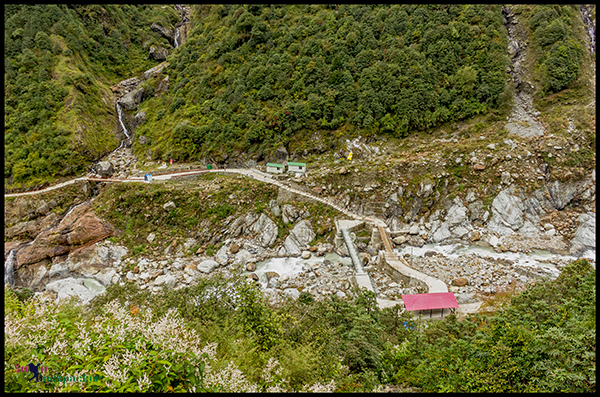
The trekking route bifurcates after Bheembali. First route bypasses Rambara and moves upwards on the hilly side, but both the route meets after Rambara. I wanted to visit the site of Rambara, so I moved on the route going to Rambara. The appearance of Mandakini River at Rambara is completely different from what it looks like at other places in the valley. The beautiful, slow-moving shallow river flow of Mandakini suddenly appears very fierce between the stone gorges at Rambara. You can instantly understand the horrific conditions during the flood after looking at the river flow there at Rambara. The fast moving glacial moraines and debris brought down hundreds of devotees between these rocks and there was no question of survival after the impact with the massive stone walls of the river gorge.

The old traditional route of Kedarnath on the left side of Mandakini River was completely destroyed beyond Rambara. Therefore, a new route is constructed on the right side of the river. Although the new route is longer and steeper than the older one, but it is also much wider and more comfortable.

After the destruction of the settlement at Rambara, there was a need to rebuild a new settlement of that scale. Slightly away from the riverbed, on the uphill trail, a new settlement is being developed to fill the void created by the flood disaster at Rambara. Chhota Lincholi and Lincholi, situated in the near vicinity, would be the major halts on the midway of this trek in the near future.

When I arrived at the small settlement of Lincholi, it was completely dark outside. The temple of Kedarnath is 6 kms from Lincholi. After seeing the GMVN guesthouse, I suddenly felt very tired, so decided to stay there for the night. Due to the fewer crowds, there was no issue regarding the availability of accommodation. I booked a shared accommodation available in a huge tent. It had 6 sleeping bags inside, so I was supposed to share that tent with 5 other people, but nobody arrived later on.
The dinner at GMVN was very simple, yet delicious enough to feed my hungry tummy. The tea offered after the dinner was very nice. After dinner, I slipped inside the sleeping bag.
Since 6 kms of trek was still left, I started very early in the next morning. I wanted to reach at the temple before the sun-rays would appear unbearable. The physical condition of my body was in much better shape than the exhausted one from the last night. I was feeling refreshed due to the good sleep.

I found nobody for the initial 2 kms, and then met the first batch of the people who were descending from the temple. With the first rays of sun on the hills, the solitude of valley was disturbed by the metallic birds. The to and fro movements of the helicopters started for the rest of the day, unless the weather condition don’t allow them to fly.

It took me two and half hours to reach at the relatively larger settlement of Kedarnath. Near the helipad, the newly constructed guesthouses and cottages of GMVN (500 meters before the main temple) gave it a fresh look and at the first glance, no sign of flood disaster was visible. As I moved closer, I could feel that fearful silence in the air.
There is a check post near the GMVN cottages, where security personnel check the registration slip of this journey. If you don’t have a registration slip already, bio-metric registration is possible on the spot, at a counter adjacent to the check post.
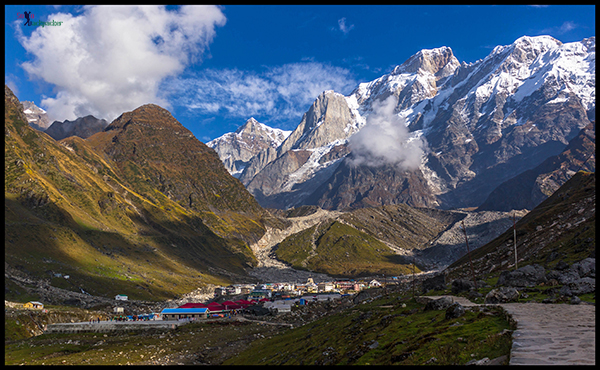

The Mandakini River appears calm and narrow near the Kedar Dham. A proper bathing ghat with steps has been constructed on a bank of the river. After crossing the bridge over Mandakini, I entered in the main street of Kedarnath Dham. It was the old settlement of Kedarnath, where the sign of devastation was visible at every step in the form of broken, dilapidated or demolished structures.
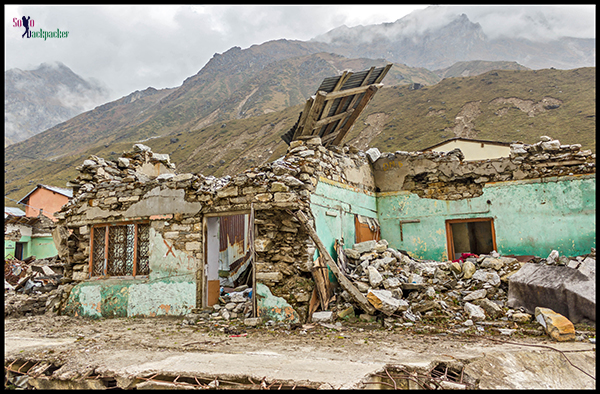
The main temple of Lord Shiva at Kedarnath was miraculously safe during the flood. When the flood water of Gandhi Sarovar carrying large chunks of moraines moved downwards with the stone boulders, a big boulder tumbled down and stop just behind the temple. The large boulder diverted the path of water from the both sides of the temple and thus the temple remains intact.

After offering my prayers at the temple of Kedarnath, I walked behind to look at the big boulder, the saviour of the main shrine. That big boulder is very sacred now and pilgrims started praying here also.

The traces of Gandhi Sarovar were visible from the backyard of the temple, but that lake was almost destroyed during the flood, so there was no point to visit that side. I was actually interested to visit Vasuki Sarovar, but it was too far. It did not look a wise decision to visit Vasuki Sarovar alone, so abandoned that idea.
After spending nearly two hours near the temple, I commenced the return journey to Gaurikund. The beautiful landscapes of the journey route were already captured by the camera, so no specific thought was there in the mind. Many people on the upward journey was more interested to know about the remaining distance, so the only task pending with me was to give them a little bit of courage and inform them about the remaining distance.
After taking few occasional breaks during the downward journey, I returned to Gaurikund in 4 hours. Luckily, a shared jeep was available directly to Guptkashi. I reached Guptkashi well in time to continue my onward journey to Rudraprayag.
This way, I completed an impromptu trip to Kedarnath Dham. Most of the time during the journey, I kept comparing the current situation at Kedarnath in view of the flood disaster. Within 3 years of the calamity, many things changed rapidly on the trekking route to Kedarnath. Few new settlements have been developed and few older one became the part of the memory. The pilgrimage to Kedarnath would be still in the shadow of the flood disaster for next 2-3 years. Perhaps, when the trekking route and nearby areas would become more developed in the coming years, the terror of that fateful night would be slowly fade away from the memories and then the people would stop looking for the stories from the past.
Few Useful Information For Kedarnath Trek:
Accommodation:
Sonaprayag: Starting point of the trek (21 kms one way trek, if you start from here). Shared jeeps are also available to Gaurikund (5 kms away). GMVN Guest House available. Online booking is possible and recommended. Other hotels/guesthouses are also available. Medical facility available. Expect to cross Sonaprayag by 0100 PM to continue on the onward journey to Kedarnath for that day.
Gaurikund: Another place to start the trek (16 kms one way trek, if you start from here). GMVN Guest House available. Online booking is possible and recommended. Other hotels/guesthouses are also available. Visit Gauri Mata Temple before starting the trek. Hot spring is no more after the disaster. You can hire mules, doli, porters etc from here. Medical facility available. Expect to cross Gaurikund by 0130 PM to continue on the onward journey to Kedarnath for that day. While on the return journey, nobody is allowed to move beyond Gaurikund after 0700 PM.
Junglechatti: 4 kms from Gaurikund. GMVN Guest House available. Online booking is possible and recommended. Other hotels/guesthouses are not available. No medical facility. Police post is there.
Bheembali: 6 kms from Gaurikund. GMVN Guest House available. Online booking is possible and recommended. Other hotels/guesthouses are not available. Medical facility available. Police post is there. Expect to cross Bheembali by 0500 PM to continue on the onward journey to Kedarnath for that day. While descending down, nobody is allowed to move beyond Bheembali after 0630 PM.
Rambara: 7 kms from Gaurikund. No settlement is there now. Only memories.
Lincholi: 11 kms from Gaurikund. GMVN Guest House available. Online booking is possible and recommended. Other hotels/guesthouses are not available. Medical facility available. Police post is there. Expect to cross Bheembali by 0600 PM to continue on the onward journey to Kedarnath for that day. While descending down, nobody is allowed to move beyond Lincholi after 0500 PM.
Kedarnath: 16 kms from Gaurikund. GMVN Guest Houses available. Online booking is possible and recommended. Other hotels/guesthouses are also available upto a limited extent. Medical facility available. Police post is there. While descending down, nobody is allowed to commence the return journey from Kedarnath after 0500 PM.
GMVN guest houses are having single room, double room cottages/huts as well as tented dormitories. Normal rates for dormitory is Rs 250-350 per night, while for cottages it is in the range of Rs. 800-1000.
Food: Food is available at every GMVN facility at the reasonable price. On the trek route, many shops are there to get the food items.
Water: Water supply is available on the entire route. There are water taps at repetitive distances to get the drinking water.
Internet/Mobile Network: Free wi-fi internet zone is available at Junglechatti, Bheembali, Lincholi and Kedarnath. BSNL (on the complete route) is the best bet, but Reliance (on the complete route) and Vodafone (upto Lincholi) is also available.
Toilets: The make-shift toilets wrapped by the tents are available at the repetitive distances on the complete trekking route.




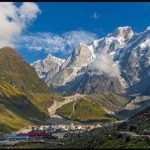
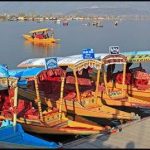
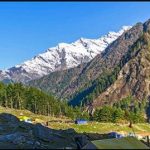

No, the temple will be closed on the next day of Deepawali
Dear Solo Backpacker Hi, me and my daughter are intended to visit Kedarnath ji around 31st May 2022 and planned to take night halt at linchule .l want to know is there any breathing problem occurred at night, due to low oxygen level, ? Then what to do ? Can I get any medical help ? I am 60 . . … Thanking you
Hi,
Would it be open if I wish to visit it in last week of December?
It gets closed by the end of October. You may trek on the route, but food and accommodation can be an issue. Manageable however. But temple will be closed.
Hello Solobackpacker,
I am planning a solo trip to kedarnath in 2 week of september.I have never been to kedarnath before but i want to visit this holy shrine.Kindly Provide me with some crucial details so that i can trek without any difficulty.
Hi Nehal, I think all the relevant and useful information is already there in both parts of Kedarnath trip. It’s a moderate two days trek with many devotees on the way. No need to worry about anything including food and accommodation. If you have any specific query, please let me know. Have a great trip. Har Har Mahadev.
Thankyou for your valuable comment.
Hi Nehal
Even I am a solo traveler planning to leave on 27 sept from Delhi ..
So if u r interested we can catch up
Hey, I am from delhi. I am planning to go in September last week.. Can we go together?
I am also visiting this month.. Anyone wants to join?
I will be travelling first time solo to Kedarnath. I am planning to visit from 24th August and returning back to 29th August. Is the time feasible for travelling solo as can’t plan in September and October due to other engagements. Please suggest the timing.
Yes, it’s good to go there. There are chances of the rain, so carry a raincoat for your comfort and also good shoes. 4-5 days are more than enough. Have a nice trip. 🙂
Is there any locker service to leave our bags in Gaurikund?
I don’t think that there is an exclusive locker service. However, you can leave your extra bags at the shops. They will charge few bucks to take care of your bags. You can rely on them.
This part of your story starts with a deeply reflective and somber mood but it is, but, natural. The large boulder arriving to save the holy shrine may be described by many as just a coincidence but I tend to look at it as a divine intervention.
The literary style of your narratives has kindled a desire in me to have your introduction – name, vocation – place of residence etc. The name Solopackpacker is not enough to satisfy me. 😉
Best regards,
Sushant Singhal
Simply amazing….enjoyed every part of your write- up, I have been to Kedarnath, but you made me relive and experience it once again……..I am going this year again to Kedarnath via trek….in June…..hopefully
It’s so nice to see this blog and in particular this post. Can I ask a few questions? Where would you be trekking from? Since you’ve been there before, is it safe for the old to spend the night at Kedarnath? My mother is 77 and reasonably fit.
Yes, It’s safe. Trekking route starts from Gaurikund.
YOUR BLOG WAS VERY HELPFUL. ITS A MUST VISIT SPOT. I HAVE ADDED IT TO MY LIST. THANKS AGAIN.
Hi dear,
Thanks for the vivid description
Is there any risk for solo lady traveler?
Hi, It’s a pilgrimage center, so there is nothing to worry about. It is perfectly safe for a solo lady traveler.
Hi, I am planning a solo trip to Kedarnath in May. I will be taking volvo bus to rishikesh and the arrival time in Rishikesh is 4.30 am. I would like to know if there will be any shared taxis or bus available early morning for Gaurikund or Sonprayag? Thanks much in advance!
Yes,3-4 buses are available directly upto Guptkashi. If you take share jeeps, then you may have to get one for Rudraprayag first and then from Rudraprayag to Guptkashi.
Dear Solo Backpacker
Thank you for such a wonderfully written article and fully inspiring. We are two ladies in our late 40s planning to travel in May 2019. Can you please let me know if the altitude affected your trek? I wasn’t very clear but is there accommodation at halfway point on the way to the temple so we can break the 16km walk into 2 days?
Hi, I did not get any problem because of the altitude. But, it doesn’t mean that it will not affect anyone. It may or may not. However, I haven’t seen anyone having any kind of altitude sickness. It’s a pretty trail with dense green forest cover, so you can expect plenty of oxygen supply. There are many accommodation options with the gap of every 4-5 kms (At least 5 places on the entire trek route), so you have choices to complete your journey at comfortable pace.
Can I go Kedarnath at Janaury ?? Lord Shiva’s idol will be there …??
No, The Temple is closed during the winter, mostly from Mid-November to Mid-April.
Very useful information about trek. But what about temperature in Kedarnath during mid October. Is it too cold and how will be the oxygen level for people with wheezing problems
Hi, Mid October is good time for Kedarnath visit. Expect cold weather during the night. Day time temperature should be OK. I didn’t feel any Oxygen level difficulty at Kedarnath. If you trek slowly, you will get good acclimatization and everything will be fine.
Hi,
That is one great article. Very informative and complete. Thanks for sharing. Can I ask, if any special shoes are required to do the trekking to Kedarnath? What do you suggest?
Hi, no special shoes required. The trekking route is very good and any shoes will serve the purpose. But try to get a shoes with good grip and ankle support. It will make you more comfortable.
Nice and vivid description. Visited Kedarnathji thrice, twice before disaster and once in 2016 after the disaster although by helicopter to and fro. Planning to Trek in October next year. Your blog is inspiring and full of those details which are very much necessary and of course you have shown the touch and feelings a real traveller possesses. My sincere thanks.
Thank you for the encouraging words. 🙂
Beautiful trip description. I am planning to take my mom in the month of Sept , I hope she will enjoy the walking distance and it will not very difficult for her. Shall I book the hotel in advance??
If possible, you should book it online in advance. September is the peak season for Uttarakhand. Better not to take any chance, while traveling with elderly parents. Have a nice trip.
It’s wonderfully potrayed the whole experience.
Thank u so much. We two girls are planning to visit this place. In mid may. It must be hot climate but hope it’s safe too for us. Plz do share some tips for us.
It is perfectly safe to travel there. No need to worry on the safety part. Enjoy your trip. 🙂
after reading ur wonderful details, want to cover that area in october
Hello,
Good to read your post. We are planning to visit Kedarnath in May. Nice to read that you can stay on the way, I was wondering how can I trek for 16hrs. How much time does it take to descend. I don’t have a good stamina but I am very interested in doing the trek. Is it doable.
Also if it starts raining are there any shelters on the way, if yes at what distance .
Being a major center of pilgrimage, you will find a lot of people from different age groups on the trail. Physical stamina also varies from person to person. So, the trek is tough, but possible. And, you will find a lot of inspiration on the way. Don’t think about 16 hours, break that in 2 hours, then 3 hours and so on. Also, the time required for descend varies from person to person. Expect rain shelters at every 3-4 kilometers. Hope you will enjoy your trek. Good Luck.
Dear Solo Packer
Thks for your Inspiring Post.
Plan to visit Kedarnath in 3rd week of Sep, what would be the expected temp be about.
Thks & Rgds
Mano
Thanks for your inspiring posts. I am an older lady,senior ,traveling solo,wanting to go to Kedarnath from Delhi. People tell me not to go alone. I don’t want to wait too long to find someone to go with. Do you think it’s safe and doable.physically ok,mentally strong.what do you advise.
?
Ma’am, you already answer your question: Physically OK, Mentally Strong. Now, there shouldn’t be any doubt. It’s perfectly safe trek. Just do it. Have a nice journey.
Dear Solo Backpacker,
Hi, me and my wife are intended to visit Kedarnathji around 19th. sept’17. Since we are of age 70 & 65 is it possible for us to trek this distance? kindly suggest.
Thanking you very much,
Parasar Chakraborty
Sir, it is 16 kms trek one way. Not too steep, but moderate. Many people of your age also do this regularly. If you have good physical stamina, you should surely do this. In case of any issue, there are lot of options for mules, palki, porters etc. Have a nice trip. 🙂
Thanks a lot. We shall try to do it.
यहां 5 बार जा चुका हूं लेकिन हादसे के बाद एक बार भी जाना नहीं हुआ आपके लेकर फोटो से पता चल रहा है कि बहुत कुछ बदल चुका है
हाँ, आपकी कहानियाँ पड़ी हैं मैंने। कभी गुवाहाटी की तरफ आना हो तो बताइयेगा।